FORD F650 2005 11.G Owners Manual
Manufacturer: FORD, Model Year: 2005, Model line: F650, Model: FORD F650 2005 11.GPages: 272, PDF Size: 1.5 MB
Page 121 of 272
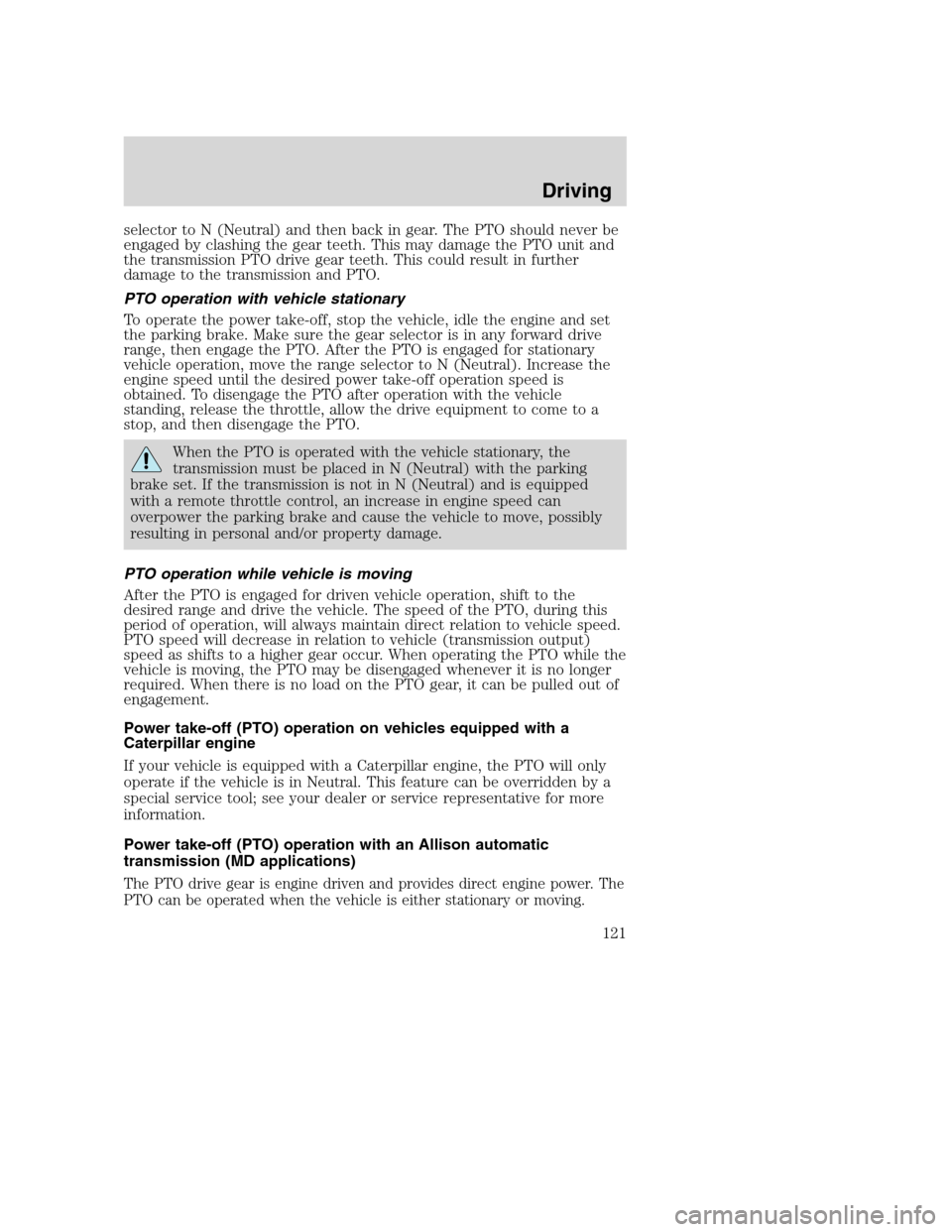
selector to N (Neutral) and then back in gear. The PTO should never be
engaged by clashing the gear teeth. This may damage the PTO unit and
the transmission PTO drive gear teeth. This could result in further
damage to the transmission and PTO.
PTO operation with vehicle stationary
To operate the power take-off, stop the vehicle, idle the engine and set
the parking brake. Make sure the gear selector is in any forward drive
range, then engage the PTO. After the PTO is engaged for stationary
vehicle operation, move the range selector to N (Neutral). Increase the
engine speed until the desired power take-off operation speed is
obtained. To disengage the PTO after operation with the vehicle
standing, release the throttle, allow the drive equipment to come to a
stop, and then disengage the PTO.
When the PTO is operated with the vehicle stationary, the
transmission must be placed in N (Neutral) with the parking
brake set. If the transmission is not in N (Neutral) and is equipped
with a remote throttle control, an increase in engine speed can
overpower the parking brake and cause the vehicle to move, possibly
resulting in personal and/or property damage.
PTO operation while vehicle is moving
After the PTO is engaged for driven vehicle operation, shift to the
desired range and drive the vehicle. The speed of the PTO, during this
period of operation, will always maintain direct relation to vehicle speed.
PTO speed will decrease in relation to vehicle (transmission output)
speed as shifts to a higher gear occur. When operating the PTO while the
vehicle is moving, the PTO may be disengaged whenever it is no longer
required. When there is no load on the PTO gear, it can be pulled out of
engagement.
Power take-off (PTO) operation on vehicles equipped with a
Caterpillar engine
If your vehicle is equipped with a Caterpillar engine, the PTO will only
operate if the vehicle is in Neutral. This feature can be overridden by a
special service tool; see your dealer or service representative for more
information.
Power take-off (PTO) operation with an Allison automatic
transmission (MD applications)
The PTO drive gear is engine driven and provides direct engine power. The
PTO can be operated when the vehicle is either stationary or moving.
Driving
121
Page 122 of 272
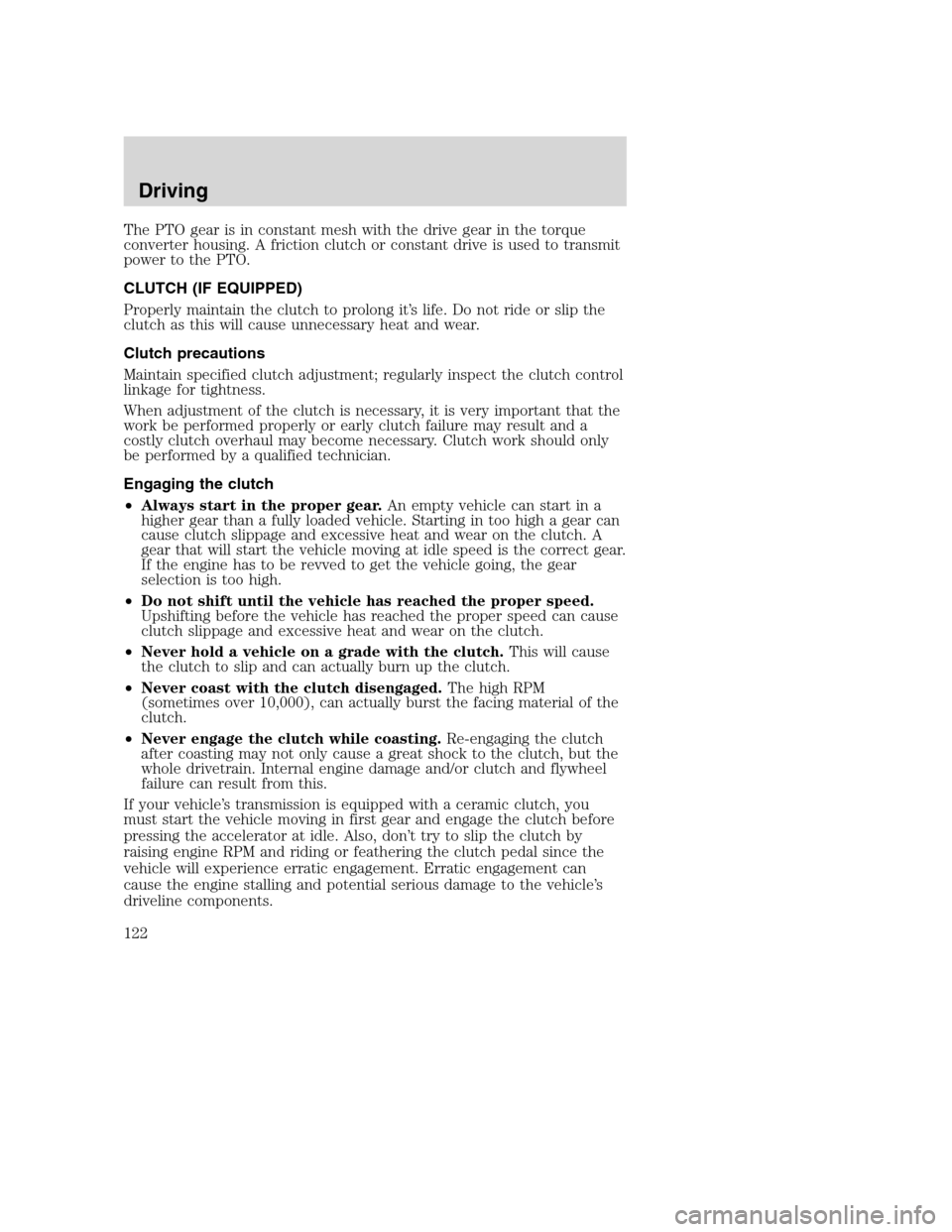
The PTO gear is in constant mesh with the drive gear in the torque
converter housing. A friction clutch or constant drive is used to transmit
power to the PTO.
CLUTCH (IF EQUIPPED)
Properly maintain the clutch to prolong it’s life. Do not ride or slip the
clutch as this will cause unnecessary heat and wear.
Clutch precautions
Maintain specified clutch adjustment; regularly inspect the clutch control
linkage for tightness.
When adjustment of the clutch is necessary, it is very important that the
work be performed properly or early clutch failure may result and a
costly clutch overhaul may become necessary. Clutch work should only
be performed by a qualified technician.
Engaging the clutch
•Always start in the proper gear.An empty vehicle can start in a
higher gear than a fully loaded vehicle. Starting in too high a gear can
cause clutch slippage and excessive heat and wear on the clutch. A
gear that will start the vehicle moving at idle speed is the correct gear.
If the engine has to be revved to get the vehicle going, the gear
selection is too high.
•Do not shift until the vehicle has reached the proper speed.
Upshifting before the vehicle has reached the proper speed can cause
clutch slippage and excessive heat and wear on the clutch.
•Never hold a vehicle on a grade with the clutch.This will cause
the clutch to slip and can actually burn up the clutch.
•Never coast with the clutch disengaged.The high RPM
(sometimes over 10,000), can actually burst the facing material of the
clutch.
•Never engage the clutch while coasting.Re-engaging the clutch
after coasting may not only cause a great shock to the clutch, but the
whole drivetrain. Internal engine damage and/or clutch and flywheel
failure can result from this.
If your vehicle’s transmission is equipped with a ceramic clutch, you
must start the vehicle moving in first gear and engage the clutch before
pressing the accelerator at idle. Also, don’t try to slip the clutch by
raising engine RPM and riding or feathering the clutch pedal since the
vehicle will experience erratic engagement. Erratic engagement can
cause the engine stalling and potential serious damage to the vehicle’s
driveline components.
Driving
122
Page 123 of 272
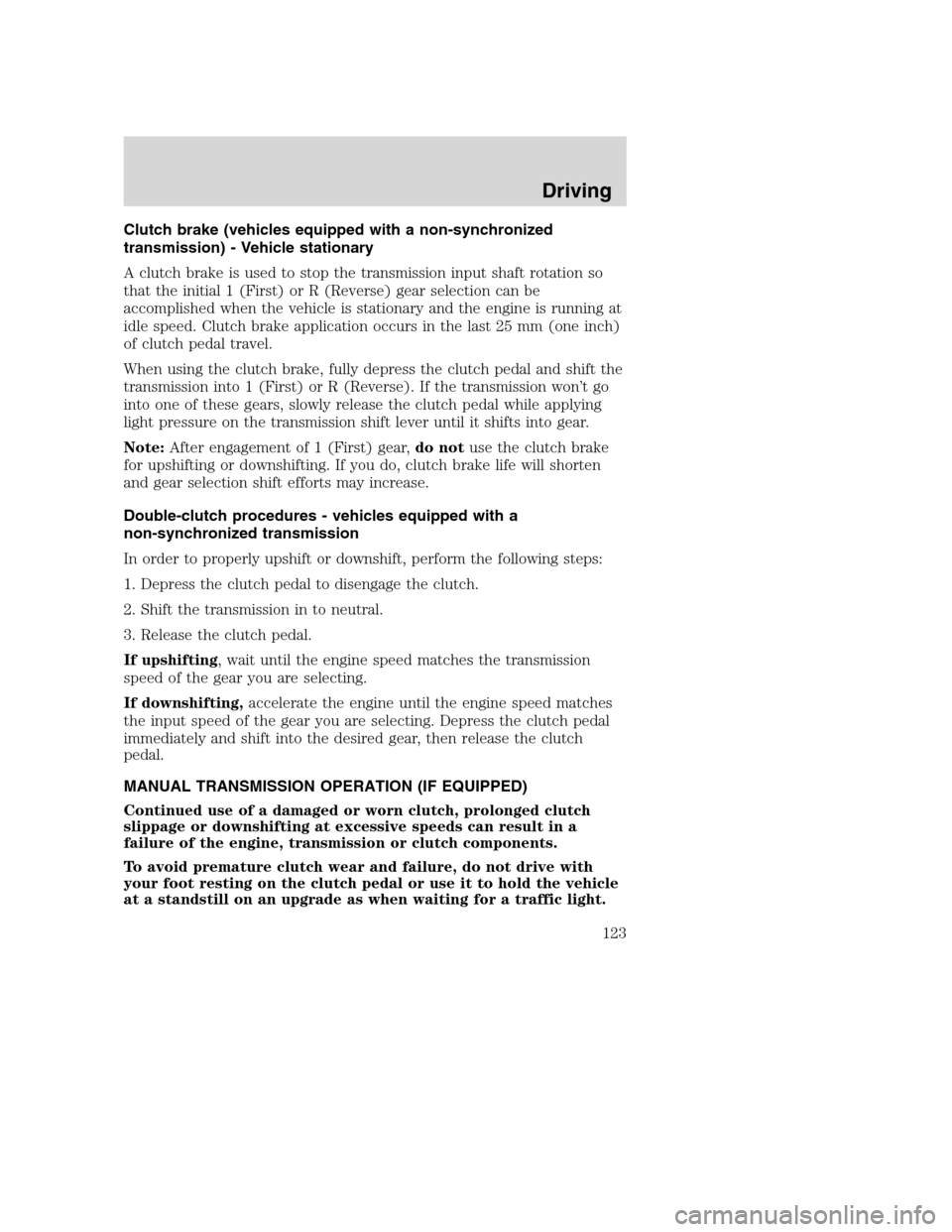
Clutch brake (vehicles equipped with a non-synchronized
transmission) - Vehicle stationary
A clutch brake is used to stop the transmission input shaft rotation so
that the initial 1 (First) or R (Reverse) gear selection can be
accomplished when the vehicle is stationary and the engine is running at
idle speed. Clutch brake application occurs in the last 25 mm (one inch)
of clutch pedal travel.
When using the clutch brake, fully depress the clutch pedal and shift the
transmission into 1 (First) or R (Reverse). If the transmission won’tgo
into one of these gears, slowly release the clutch pedal while applying
light pressure on the transmission shift lever until it shifts into gear.
Note:After engagement of 1 (First) gear,do notuse the clutch brake
for upshifting or downshifting. If you do, clutch brake life will shorten
and gear selection shift efforts may increase.
Double-clutch procedures - vehicles equipped with a
non-synchronized transmission
In order to properly upshift or downshift, perform the following steps:
1. Depress the clutch pedal to disengage the clutch.
2. Shift the transmission in to neutral.
3. Release the clutch pedal.
If upshifting, wait until the engine speed matches the transmission
speed of the gear you are selecting.
If downshifting,accelerate the engine until the engine speed matches
the input speed of the gear you are selecting. Depress the clutch pedal
immediately and shift into the desired gear, then release the clutch
pedal.
MANUAL TRANSMISSION OPERATION (IF EQUIPPED)
Continued use of a damaged or worn clutch, prolonged clutch
slippage or downshifting at excessive speeds can result in a
failure of the engine, transmission or clutch components.
To avoid premature clutch wear and failure, do not drive with
your foot resting on the clutch pedal or use it to hold the vehicle
at a standstill on an upgrade as when waiting for a traffic light.
Driving
123
Page 124 of 272
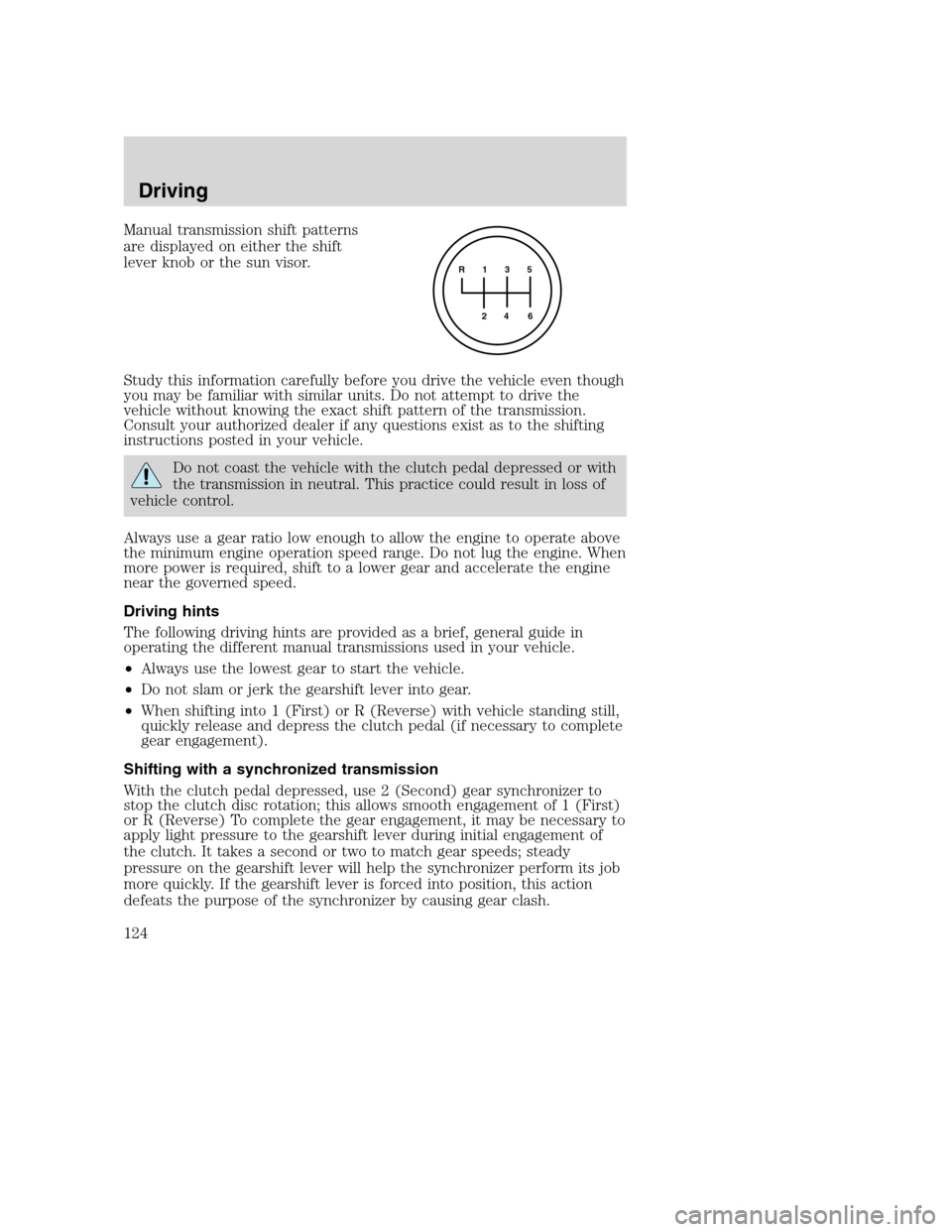
Manual transmission shift patterns
are displayed on either the shift
lever knob or the sun visor.
Study this information carefully before you drive the vehicle even though
you may be familiar with similar units. Do not attempt to drive the
vehicle without knowing the exact shift pattern of the transmission.
Consult your authorized dealer if any questions exist as to the shifting
instructions posted in your vehicle.
Do not coast the vehicle with the clutch pedal depressed or with
the transmission in neutral. This practice could result in loss of
vehicle control.
Always use a gear ratio low enough to allow the engine to operate above
the minimum engine operation speed range. Do not lug the engine. When
more power is required, shift to a lower gear and accelerate the engine
near the governed speed.
Driving hints
The following driving hints are provided as a brief, general guide in
operating the different manual transmissions used in your vehicle.
•Always use the lowest gear to start the vehicle.
•Do not slam or jerk the gearshift lever into gear.
•When shifting into 1 (First) or R (Reverse) with vehicle standing still,
quickly release and depress the clutch pedal (if necessary to complete
gear engagement).
Shifting with a synchronized transmission
With the clutch pedal depressed, use 2 (Second) gear synchronizer to
stop the clutch disc rotation; this allows smooth engagement of 1 (First)
or R (Reverse) To complete the gear engagement, it may be necessary to
apply light pressure to the gearshift lever during initial engagement of
the clutch. It takes a second or two to match gear speeds; steady
pressure on the gearshift lever will help the synchronizer perform its job
more quickly. If the gearshift lever is forced into position, this action
defeats the purpose of the synchronizer by causing gear clash.
R 1 3 5
4
6 2
Driving
124
Page 125 of 272
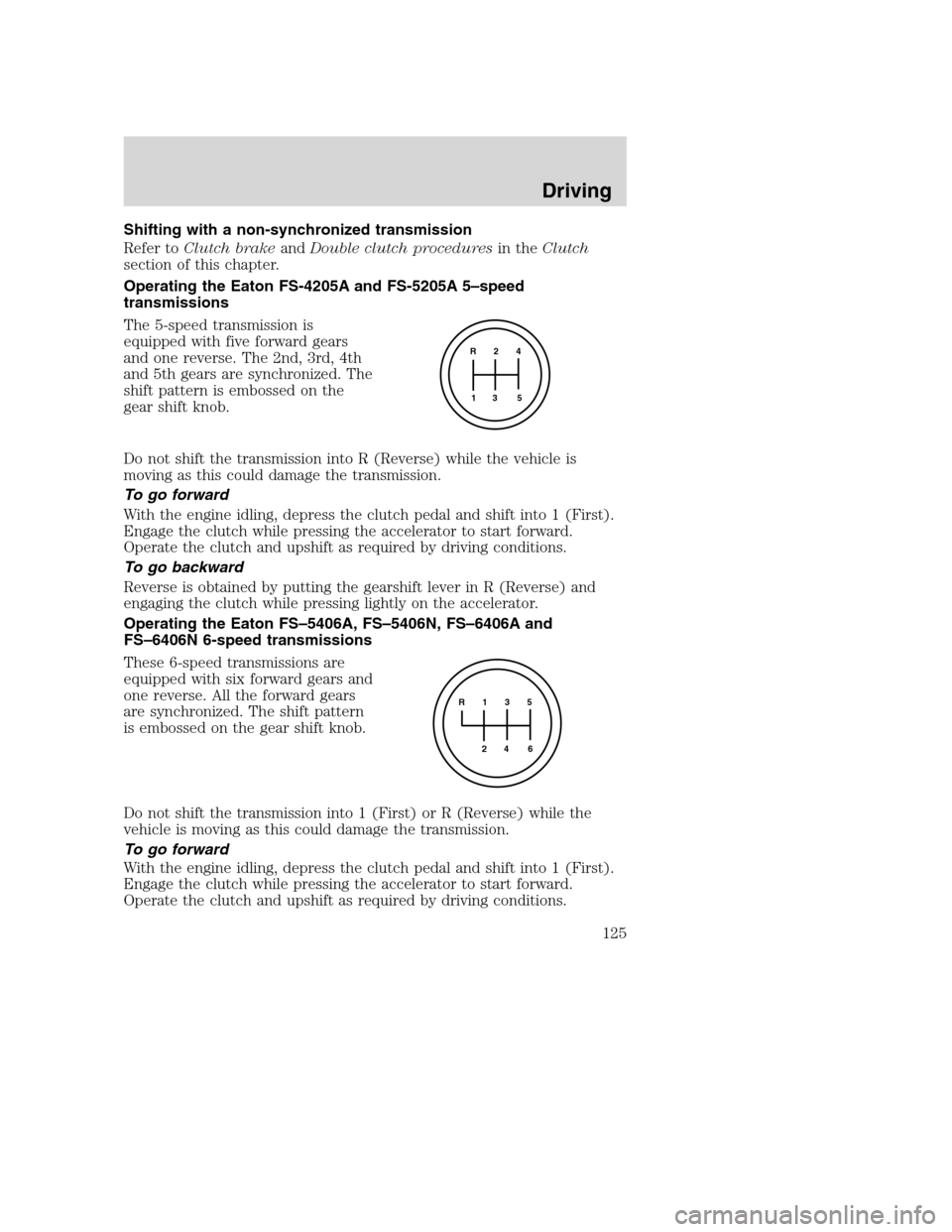
Shifting with a non-synchronized transmission
Refer toClutch brakeandDouble clutch proceduresin theClutch
section of this chapter.
Operating the Eaton FS-4205A and FS-5205A 5–speed
transmissions
The 5-speed transmission is
equipped with five forward gears
and one reverse. The 2nd, 3rd, 4th
and 5th gears are synchronized. The
shift pattern is embossed on the
gear shift knob.
Do not shift the transmission into R (Reverse) while the vehicle is
moving as this could damage the transmission.
To go forward
With the engine idling, depress the clutch pedal and shift into 1 (First).
Engage the clutch while pressing the accelerator to start forward.
Operate the clutch and upshift as required by driving conditions.
To go backward
Reverse is obtained by putting the gearshift lever in R (Reverse) and
engaging the clutch while pressing lightly on the accelerator.
Operating the Eaton FS–5406A, FS–5406N, FS–6406A and
FS–6406N 6-speed transmissions
These 6-speed transmissions are
equipped with six forward gears and
one reverse. All the forward gears
are synchronized. The shift pattern
is embossed on the gear shift knob.
Do not shift the transmission into 1 (First) or R (Reverse) while the
vehicle is moving as this could damage the transmission.
To go forward
With the engine idling, depress the clutch pedal and shift into 1 (First).
Engage the clutch while pressing the accelerator to start forward.
Operate the clutch and upshift as required by driving conditions.
R 2 4
3 5 1
R 1 3 5
4
6 2
Driving
125
Page 126 of 272
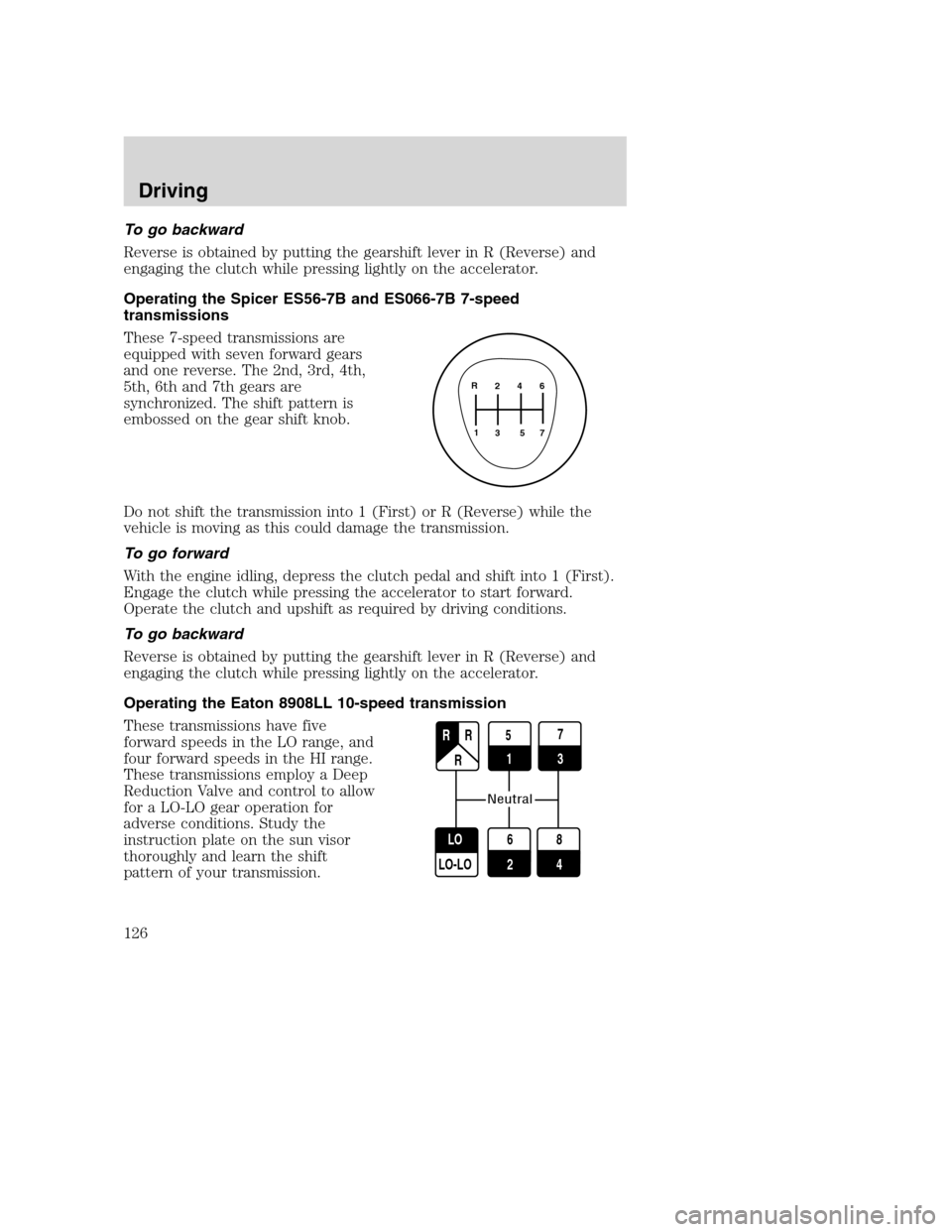
To go backward
Reverse is obtained by putting the gearshift lever in R (Reverse) and
engaging the clutch while pressing lightly on the accelerator.
Operating the Spicer ES56-7B and ES066-7B 7-speed
transmissions
These 7-speed transmissions are
equipped with seven forward gears
and one reverse. The 2nd, 3rd, 4th,
5th, 6th and 7th gears are
synchronized. The shift pattern is
embossed on the gear shift knob.
Do not shift the transmission into 1 (First) or R (Reverse) while the
vehicle is moving as this could damage the transmission.
To go forward
With the engine idling, depress the clutch pedal and shift into 1 (First).
Engage the clutch while pressing the accelerator to start forward.
Operate the clutch and upshift as required by driving conditions.
To go backward
Reverse is obtained by putting the gearshift lever in R (Reverse) and
engaging the clutch while pressing lightly on the accelerator.
Operating the Eaton 8908LL 10-speed transmission
These transmissions have five
forward speeds in the LO range, and
four forward speeds in the HI range.
These transmissions employ a Deep
Reduction Valve and control to allow
for a LO-LO gear operation for
adverse conditions. Study the
instruction plate on the sun visor
thoroughly and learn the shift
pattern of your transmission.
2 4 6
3 5 71 R
27
3
6
2 LO
LO-LO
8
4
R R
R R
5 1
1
Neutral
Driving
126
Page 127 of 272
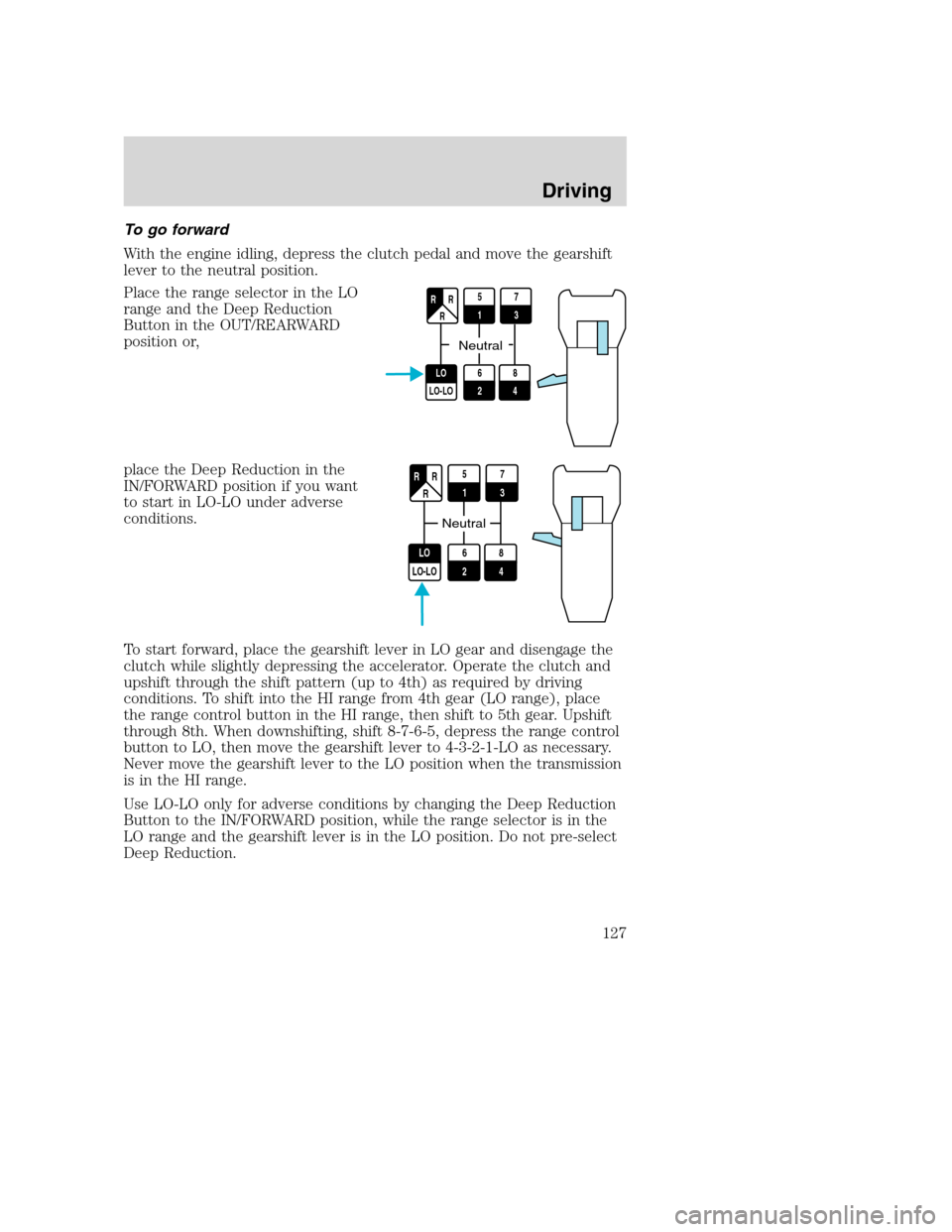
To go forward
With the engine idling, depress the clutch pedal and move the gearshift
lever to the neutral position.
Place the range selector in the LO
range and the Deep Reduction
Button in the OUT/REARWARD
position or,
place the Deep Reduction in the
IN/FORWARD position if you want
to start in LO-LO under adverse
conditions.
To start forward, place the gearshift lever in LO gear and disengage the
clutch while slightly depressing the accelerator. Operate the clutch and
upshift through the shift pattern (up to 4th) as required by driving
conditions. To shift into the HI range from 4th gear (LO range), place
the range control button in the HI range, then shift to 5th gear. Upshift
through 8th. When downshifting, shift 8-7-6-5, depress the range control
button to LO, then move the gearshift lever to 4-3-2-1-LO as necessary.
Never move the gearshift lever to the LO position when the transmission
is in the HI range.
Use LO-LO only for adverse conditions by changing the Deep Reduction
Button to the IN/FORWARD position, while the range selector is in the
LO range and the gearshift lever is in the LO position. Do not pre-select
Deep Reduction.
5
17
3
6
2 LO
LO-LO
8
4
R R
R
Neutral
5
17
3
6
2 LO
LO-LO
8
4
R R
R
Neutral
Driving
127
Page 128 of 272
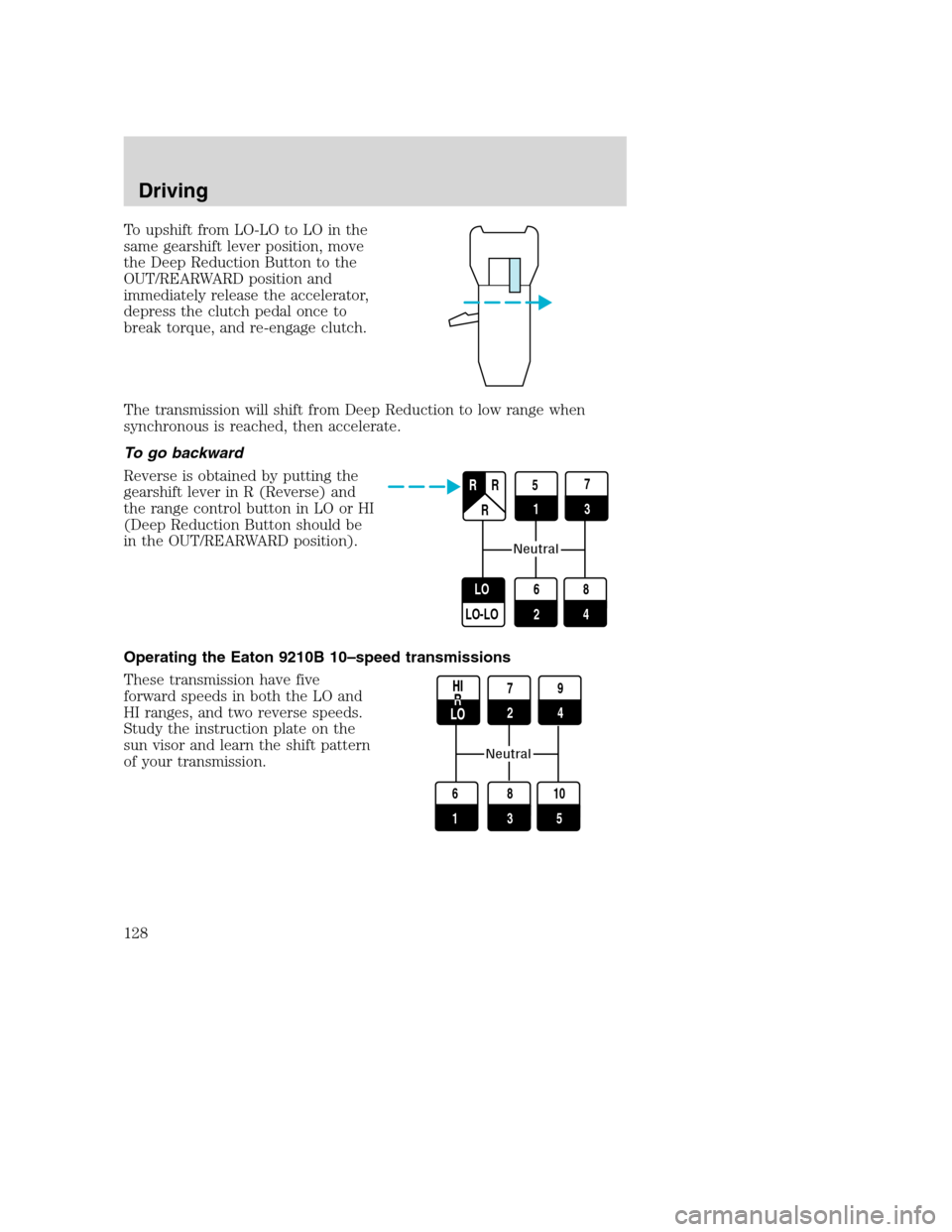
To upshift from LO-LO to LO in the
same gearshift lever position, move
the Deep Reduction Button to the
OUT/REARWARD position and
immediately release the accelerator,
depress the clutch pedal once to
break torque, and re-engage clutch.
The transmission will shift from Deep Reduction to low range when
synchronous is reached, then accelerate.
To go backward
Reverse is obtained by putting the
gearshift lever in R (Reverse) and
the range control button in LO or HI
(Deep Reduction Button should be
in the OUT/REARWARD position).
Operating the Eaton 9210B 10–speed transmissions
These transmission have five
forward speeds in both the LO and
HI ranges, and two reverse speeds.
Study the instruction plate on the
sun visor and learn the shift pattern
of your transmission.
27
3
6
2 LO
LO-LO
8
4
R R
R R
5 1
1
Neutral
7
29
4
8
3 6
1
10
5
R
Neutral
Driving
128
Page 129 of 272
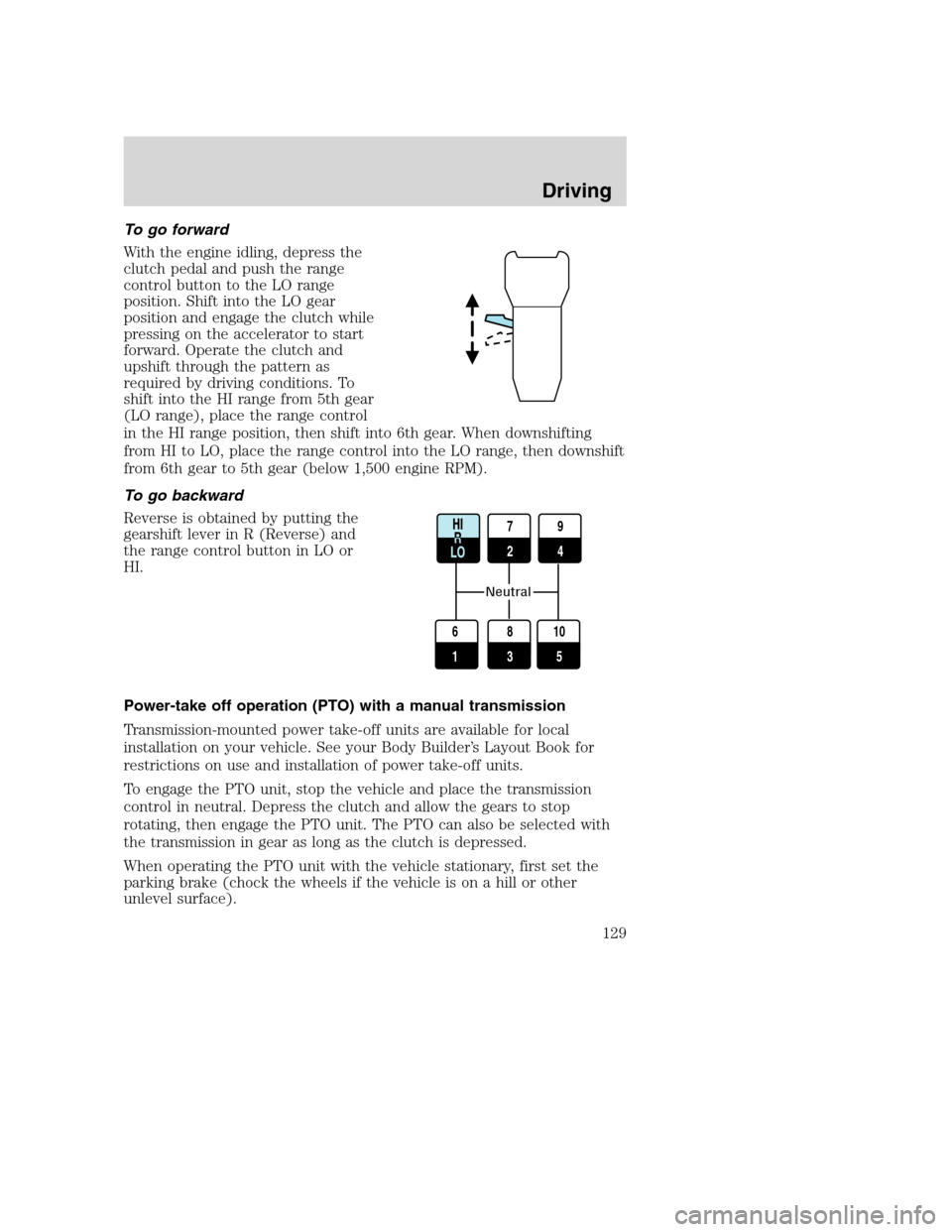
To go forward
With the engine idling, depress the
clutch pedal and push the range
control button to the LO range
position. Shift into the LO gear
position and engage the clutch while
pressing on the accelerator to start
forward. Operate the clutch and
upshift through the pattern as
required by driving conditions. To
shift into the HI range from 5th gear
(LO range), place the range control
in the HI range position, then shift into 6th gear. When downshifting
from HI to LO, place the range control into the LO range, then downshift
from 6th gear to 5th gear (below 1,500 engine RPM).
To go backward
Reverse is obtained by putting the
gearshift lever in R (Reverse) and
the range control button in LO or
HI.
Power-take off operation (PTO) with a manual transmission
Transmission-mounted power take-off units are available for local
installation on your vehicle. See your Body Builder’s Layout Book for
restrictions on use and installation of power take-off units.
To engage the PTO unit, stop the vehicle and place the transmission
control in neutral. Depress the clutch and allow the gears to stop
rotating, then engage the PTO unit. The PTO can also be selected with
the transmission in gear as long as the clutch is depressed.
When operating the PTO unit with the vehicle stationary, first set the
parking brake (chock the wheels if the vehicle is on a hill or other
unlevel surface).
7
29
4
8
3 6
1
10
5
R
Neutral
Driving
129
Page 130 of 272
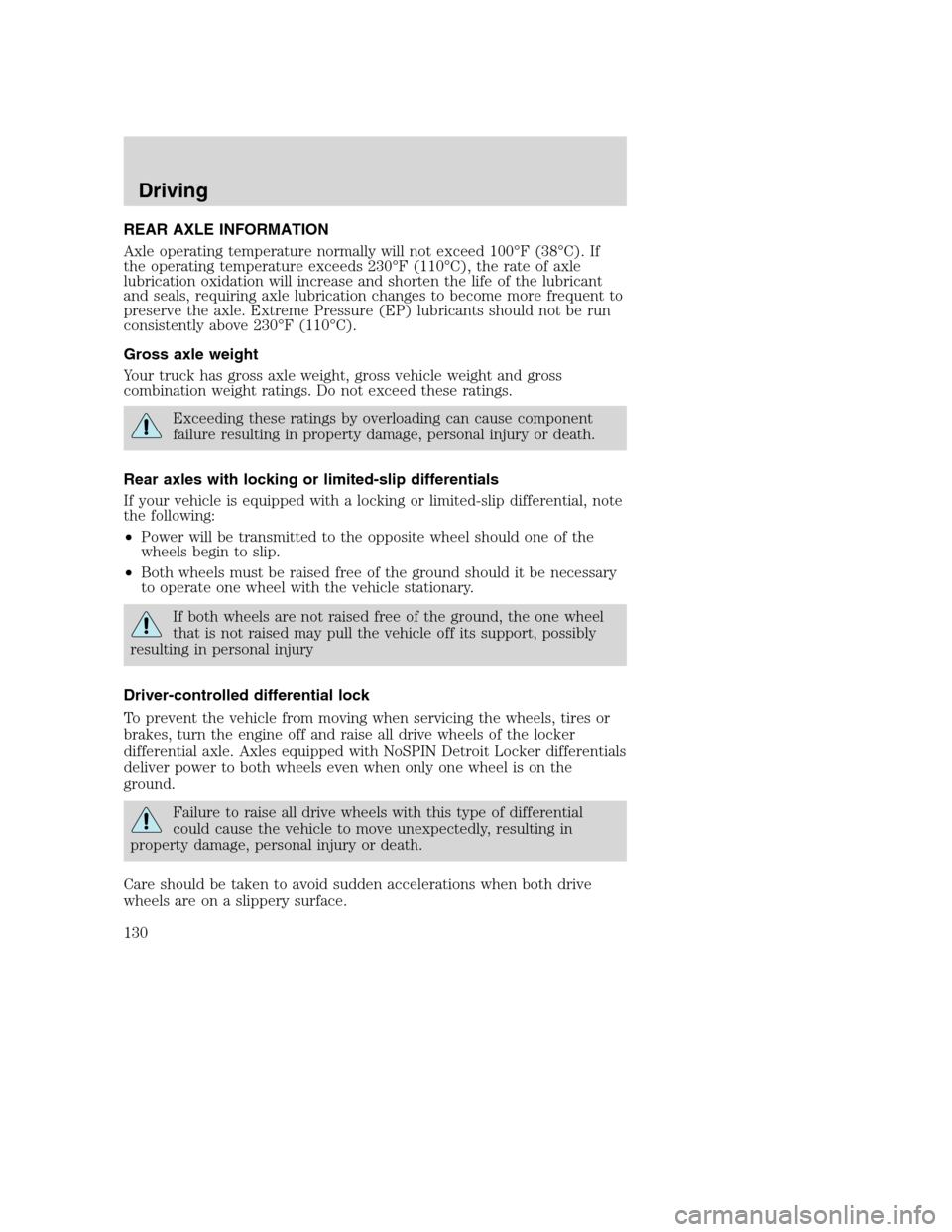
REAR AXLE INFORMATION
Axle operating temperature normally will not exceed 100°F (38°C). If
the operating temperature exceeds 230°F (110°C), the rate of axle
lubrication oxidation will increase and shorten the life of the lubricant
and seals, requiring axle lubrication changes to become more frequent to
preserve the axle. Extreme Pressure (EP) lubricants should not be run
consistently above 230°F (110°C).
Gross axle weight
Your truck has gross axle weight, gross vehicle weight and gross
combination weight ratings. Do not exceed these ratings.
Exceeding these ratings by overloading can cause component
failure resulting in property damage, personal injury or death.
Rear axles with locking or limited-slip differentials
If your vehicle is equipped with a locking or limited-slip differential, note
the following:
•Power will be transmitted to the opposite wheel should one of the
wheels begin to slip.
•Both wheels must be raised free of the ground should it be necessary
to operate one wheel with the vehicle stationary.
If both wheels are not raised free of the ground, the one wheel
that is not raised may pull the vehicle off its support, possibly
resulting in personal injury
Driver-controlled differential lock
To prevent the vehicle from moving when servicing the wheels, tires or
brakes, turn the engine off and raise all drive wheels of the locker
differential axle. Axles equipped with NoSPIN Detroit Locker differentials
deliver power to both wheels even when only one wheel is on the
ground.
Failure to raise all drive wheels with this type of differential
could cause the vehicle to move unexpectedly, resulting in
property damage, personal injury or death.
Care should be taken to avoid sudden accelerations when both drive
wheels are on a slippery surface.
Driving
130